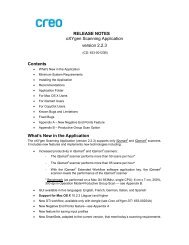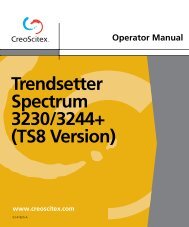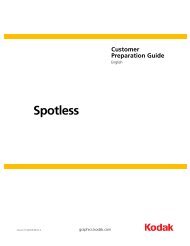Harmony - Kodak
Harmony - Kodak
Harmony - Kodak
- No tags were found...
Create successful ePaper yourself
Turn your PDF publications into a flip-book with our unique Google optimized e-Paper software.
<strong>Harmony</strong>Release 1.2Release Notes06-3169B-BRevised April 2000
Copyright © 2000 by Creo Products Inc. All rights reserved. Creo Products Inc. reserves the right to make changes, atNo part of this publication may be reproduced, stored in a any time and without notice, to this document or theretrieval system, or transmitted, in any form by any means, products that it describes to improve reliability, function, orelectronic, mechanical, photocopying, recording, ordesign. Creo Products Inc. assumes no liability for technicalotherwise, without the express written permission of Creo or editorial errors or omissions made herein; not forProducts Inc.incidental, consequential, indirect, or special damages,including, without limitation, loss of use, loss or alterationThis document is also distributed in Adobe Systemsof data, delays, or lost profits or savings arising from theIncorporated’s PDF (Portable Document Format). You areuse of this document or the product that it accompanies.allowed to reproduce the document from the PDF file forinternal use. Copies produced from the PDF file must bereproduced in whole, including the copyright disclaimernotice.. . . . . . . . . . . . . . . . . . . . . . . . . . . . . . . . . . . . . . . . . . . . . . . . . . . . . . . . . . . . . . . . . . . . . . . . . . . . . . . . . . . . . . . . . . . . . . . . . . . . . . . . . . . . . . . . . . . . . . . . . . . . . . . . . . . .PostScript is a registered trademark of Adobe Systems <strong>Harmony</strong> is a trademark of Creo Products Inc.Incorporated.Creo and the Creo logo are registered trademarks of Creo Other brand or product names are the trademarks orProducts Inc.registered trademarks of their respective holders.. . . . . . . . . . . . . . . . . . . . . . . . . . . . . . . . . . . . . . . . . . . . . . . . . . . . . . . . . . . . . . . . . . . . . . . . . . . . . . . . . . . . . . . . . . . . . . . . . . . . . . . . . . . . . . . . . . . . . . . . . . . . . . . . . . . .CreoScitex Inc.3700 Gilmore WayBurnaby, BCCanada V5G 4M1Tel: (1) (604) 451-2700Fax: (1) (604) 437-9891http://www.creoscitex.comCreoScitex N.V.Excelsiorlaan 211930 ZaventemBelgiumTel: (32) (2) 711-1400Fax:(32) (2) 720-9671http://www.creoscitex.com06-3169B-BRevised April 2000
CONTENTSIntroduction .......................................................................................... 1What Is in These Release Notes .......................................................................................... 1Conventions Used ................................................................................................................ 1Your Comments .................................................................................................................... 2CreoScitex Online.................................................................................................................. 2New Features ........................................................................................ 3Creating New Transfer Calibration Curves ........................................................................... 3Saving a Current Curve As a Target .................................................................................... 5Compensating for Undesirable High Density ........................................................................ 7Adjusting for Peak Density Below Solid Values .................................................................... 9Eliminating Undesirable Highlight Tint Values ...................................................................... 11Database Consistency Check .............................................................................................. 12Assigning Custom Medium Index Numbers ......................................................................... 12Screening System and Dependent Curve Attributes ............................................................ 17Importing Delta Process Calibration Files ............................................................................ 18Enhancements ...................................................................................... 19Database File Format Detected When Importing Curves ..................................................... 19Curve Window and Strip Reader Input Relationship ............................................................ 22Enhanced Strip Selection on Strip Reader Input Dialog Box ................................................ 22Problems Fixed ..................................................................................... 25Synchronization of Current Curves Linked to Derived Calibration Curves ........................... 25X-Rite DTP32 Strip Configuration Problem .......................................................................... 27Matching One Curve and CMYK Curves Curve Sets ........................................................... 27Known Problems .................................................................................. 28Online Help Unavailable ....................................................................................................... 28Dialog Box May Disappear When Repositioned ................................................................... 28Using <strong>Harmony</strong> ..................................................................................... 29New Terminology .................................................................................................................. 29New Screening Attribute Order in Dialog Boxes ................................................................... 29More Options Limiting Calibration Curve Use With Dot Shape ............................................ 30Revised April 2000i
IntroductionYour CommentsEvery effort has been made to provide you with accurate and useful informationin this document. We would like to know if our documentation meets yourrequirements.• Can you find the information you are looking for?• Does this document help you solve any problems that occur?• What can be improved?CreoScitex Inc.Attn: Documentation Group3700 Gilmore WayBurnaby, British ColumbiaCanada V5G 4M1Phone: (604) 451-2700Fax: (604) 437-9891Email: creodocs@creoscitex.comCreoScitex OnlineDo you have questions concerning CreoScitex products? Visit us at:http://www.creoscitex.com2 Revised April 2000
New FeaturesNEW FEATURESThis section lists new features added in <strong>Harmony</strong> software release 1.2.Creating New Transfer Calibration Curves<strong>Harmony</strong> now lets you create a new transfer calibration curve. A transfercalibration curve can be built from a target and current curve. However, unlikea derived calibration curve, there is no saved link between the transfercalibration curve and the target and current curve used to create it. You will findthis feature useful if you want to edit the shape of a calibration curve withoutadjusting the shape of the current curve linked to it. You can also create a newtransfer calibration curve that is not based on a current and target curve—thatis, a linear curve.Note: <strong>Harmony</strong> still lets you convert a derived calibration curve to a transfercalibration curve. This is useful if you decide after you create a calibrationcurve that you want to experiment with the calibration curve’s shapewithout adjusting the current curve that it is linked to.Revised April 2000 3
New Features3. Save the curve.For more information about saving curves, see the <strong>Harmony</strong> User Guide.4. If you want to create a transfer calibration curve from a derived origin—thatis, from current and target curves in your <strong>Harmony</strong> database—select theDerived Origin check box.BrowsebuttonBrowsebuttonFigure 3: New Transfer Curve dialog box (derived origin)5. Under Current Curve, click the Browse button to search for the target curveyou want.6. Under Target Curve, click the Browse button to search for the current curveyou want.7. Click OK.8. Save the curve.For more information about saving curves, see the <strong>Harmony</strong> User Guide.For more information about creating a transfer calibration curve, see the<strong>Harmony</strong> User Guide.Saving a Current Curve As a Target<strong>Harmony</strong> now lets you save a current curve as a target. This means that if youwant to make your current printing response a target, you don’t need toremeasure the tints on the sample; you simply use the Save Current Curve Asoption to save the current curve as a target.Revised April 2000 5
New FeaturesThis feature is useful if you are running a job on multiple presses and you like theresults you get on one particular press. By saving a current curve created fromoutput on this press as a target, and then building calibration curves from thistarget and the current responses on the other presses, you can match the resultsyou like on all presses.When you save a current curve as a target, the current curve does not changeand is retained in the <strong>Harmony</strong> database when you save it as a target.To save a current curve as a target:1. Open the current curve you want to save as a target.For more information about opening curves, see the <strong>Harmony</strong> User Guide.The Current Curve window displays.Figure 4: Current Curve window6 Revised April 2000
New Features2. From the File menu, select Save Curve As.Or:Right-click the Current Curve window to display the shortcut menu, and thenselect Save Curve As.The Save Current Curve As dialog box displays.Figure 5: Save Current Curve As dialog box3. Select the Target Curve tab.4. In the Curve box, type a name for the target curve.5. Click Save.The curve is saved as a target curve in the <strong>Harmony</strong> database.Compensating for Undesirable High DensityThe Density Calibration option lets you compensate for an output device thatproduces higher ink densities than you want or can achieve on press. <strong>Harmony</strong>compensates for high densities by screening solid tint values.For example, density calibration is useful if you have a high-density proofingdevice and you want to reduce the density to match the lower densities producedon your press. This lets you achieve a proof that better represents the densitylevels you can achieve on press.You can calibrate density only if you select the Paper output type in <strong>Harmony</strong>—that is, if you are calibrating a printed result. For more information aboutchoosing output types, see the <strong>Harmony</strong> User Guide.Revised April 2000 7
New FeaturesIMPORTANT:Density calibration compromises the halftone integrity of your output. Youcannot achieve dot-for-dot representation if you calibrate density. Therefore,screening effects, such as moiré, may not appear the same on your finaloutput.IMPORTANT:You can only calibrate density if your RIP can screen solid tints.To calibrate density:1. Create the target curve and current curves that you want to use to build aderived calibration curve with density calibration enabled.Make sure you enter the solid density value—measured from your sampletint bar—in the Solid Density box on both the Target Curve and Current Curvewindows.Enter yoursolid densityvalue.Figure 6: Target Curve windowNote: If you are using a CMYK Curves curve set, make sure that you enterthe solid density value for each measured color in the curve window.For more detail about creating target, current, and derived calibrationcurves, see the <strong>Harmony</strong> User Guide.8 Revised April 2000
New FeaturesIMPORTANT:You must ensure that the solid density value for your target curve is lessthan the solid density value for your current curve. If the target value isnot less than the current value, a <strong>Harmony</strong> warning displays and you willnot be able to calibrate density.2. Create the derived calibration curve.The Calibration Curve window displays.<strong>Harmony</strong> resamplesthe curve when youselect Calibrate Density.Figure 7: Calibration Curve window3. Select the Calibrate Density check box in the calibration curve window toenable density calibration.4. Save the curve.For more information about saving curves, see the <strong>Harmony</strong> User Guide.Note: If density calibration is enabled, <strong>Harmony</strong> uses the Murray-Daviesformula to resample the curve correctly; it does not simply scale thecurve.For more information about density calibration, see the <strong>Harmony</strong> UserGuide.Adjusting for Peak Density Below Solid ValuesIf you have a printing situation where solid tint values have lower measureddensities than screened tint values on the final output, <strong>Harmony</strong> now lets you"cut back" or eliminate the solid values on target curves and transfer calibrationcurves.Revised April 2000 9
New FeaturesThis feature is useful if you have a flexographic workflow. In flexography, solidtints on plate can produce lower densities on the final printed output thanscreened tints. On flexographic plates, solid tint values can carry less ink thanscreened values. This means lower tint values can actually achieve higherdensities on press. See Figure 8 for a graphical illustration.Peak density happens at89%, not 100% solid.Figure 8: Graph of peak densities below solid values<strong>Harmony</strong> compensates for peak densities below solid values by screening thesolid tints.You can cut back your target and transfer calibration curve solid tints only if youroutput type is Film or Plate—that is, if you are calibrating film or plates. For moreinformation about choosing output types, see the <strong>Harmony</strong> User Guide.IMPORTANTCutting back target and transfer calibration curve solid tints compromises thehalftone integrity of your output. You cannot achieve dot-for-dotrepresentation. Therefore, screening effects, such as moiré, may not appearthe same on your final output.IMPORTANT:You can only cut back target or transfer curve solid tints if your RIP canscreen solid tints.To cut back solid tints:1. Open the target curve or transfer calibration curve you want to use.For more information about opening curves, see the <strong>Harmony</strong> User Guide.The Target Curve or Transfer Calibration Curve window displays.10 Revised April 2000
New Features2. In the Maximum Tone box, type the maximum tone value that you want—forexample 90.Type themaximumtone value.Figure 9: Target Curve window (solid cutback)3. Save the curve.For more information about saving curves, see the <strong>Harmony</strong> User Guide.Note: If you create a derived calibration curve using a target curve that hasthe solids cut back, the derived calibration curve will inherit themaximum tone value of the target curve.For more detail on adjusting for peak density below solid values, see the<strong>Harmony</strong> User Guide.Eliminating Undesirable Highlight Tint Values<strong>Harmony</strong> lets you "cut off" or eliminate undesirable tint values in the highlightsof target and transfer calibration curves. You can use this feature for any outputtype—Film, Plate, or Paper. For more information about choosing output types,see the <strong>Harmony</strong> User Guide.Cutting off the highlights is useful if you make film or plates for flexography.Eliminating highlights on a flexographic plate is desirable because smaller dotscan actually produce higher densities than larger dots on the final printedoutput. Fine dots on a flexographic plate can bend during the printing process,rendering more ink on the paper than larger dots. These undesirable dots inhighlight areas are called scum dots.To cut off highlight tints:1. Open the target or transfer calibration curve.For more information about opening curves, see the <strong>Harmony</strong> User Guide.The Target Curve or Transfer Calibration Curve window displays.Revised April 2000 11
New Features2. In the Minimum Tint box, type the minimum tint value that you want.Type aminimumtint value.Figure 10: Target Curve window (highlight cut off)3. Save the curve.For more information about saving curves, see the <strong>Harmony</strong> User Guide.Note: If you cut off the highlights of a target curve linked to a derivedcalibration curve, <strong>Harmony</strong> will automatically apply the same cutoffto the derived calibration curve.For more detail about cutting off highlights, see the <strong>Harmony</strong> User Guide.Database Consistency CheckDeltaWhen you start <strong>Harmony</strong>, your Delta system will check to ensure that the curveproperties of the curves in your <strong>Harmony</strong> database match the properties in thePostScript Printer Description (PPD) file(s) that you currently have loaded.If properties of the curves in your <strong>Harmony</strong> database don’t appear in the PPDfile, <strong>Harmony</strong> displays a dialog box indicating which curves have properties thatdon’t match those in the currently loaded PPD file(s).For more information about the database consistency check, see the <strong>Harmony</strong>reference documentation for a Delta workflow.Assigning Custom Medium Index NumbersAllegro 2.0If your workflow requires you to limit or force calibration curve selection by theRIP, you need to assign a medium index or custom medium index to calibrationcurves that you want available for selection by the RIP. You use <strong>Harmony</strong> toassign the medium index or custom medium index to curves.12 Revised April 2000
New FeaturesFor more information on <strong>Harmony</strong> and medium index, see the <strong>Harmony</strong>Reference Guide for iMPAct Workflow.Assigning a Medium Index to an Existing Calibration CurveMost often, you will want to assign a medium index or custom medium index toan existing calibration curve.To assign a medium index to an existing calibration curve:1. Open the Calibration Curve window for the calibration curve you want toassign a medium index number to.For more detail on opening curves, see the <strong>Harmony</strong> User Guide.2. From the Edit menu, select Curve Properties.Or:Right-click on the Calibration Curve window to display the shortcut menu,then select Curve Properties.The Calibration Curve Properties dialog box displays.Figure 11: Calibration Curves Properties dialog box3. Click the Medium tab.4. Select the Medium check box.5. If the medium you want to use displays in the Medium list, select the checkbox beside it in the list box.Revised April 2000 13
New Features6. If the medium you want to assign to the calibration curve is not displayed inthe Medium list, click the Add button to assign a custom medium index.Note: If you are assigning a custom medium index for the first time, theMedium will not include any custom medium index numbers, so youmust click the Add button. A custom medium index displays in theMedium list only if you have assigned the number to a calibrationcurve previously.The New Medium dialog box displays.Figure 12: New Medium dialog box7. Type the custom medium index number you want in the medium name box,then click OK.IMPORTANT:Ensure that the medium index number you type is correct and valid. Youmust type numeric values only; no alpha or special characters are allowed.If the medium index number is incorrect, you will not achieve desired14 Revised April 2000
New Featuresresults on your final output. If the medium index number is invalid—thatis, it is not one of the medium index numbers configured at the RIP, thenthe job will fail at the RIP.See the Allegro RIP Reference Guide for a list of valid medium indexnumbers.8. The New Medium dialog box closes, and the Calibration Curve Propertiesdialog box displays again.Notice that the custom medium index you typed is added and selected in theMedium list.If the calibration curve already had a medium index assigned to it, then boththe previous medium index number and the new medium index number areselected in the Medium list. See Figure 13 for an illustration. This means thatthe calibration curve now has two medium index numbers assigned to it.A medium indexpreviously assignedis still selected.The custom mediumindex you addeddisplays and isselected in theMedium list.Figure 13: Calibration Curve Properties dialog box9. If required, clear the check boxes for all medium index numbers that youdon’t want assigned to the calibration curve.IMPORTANT:A calibration curve can have more than one medium index numberassigned to it. Ensure that only the medium index numbers you want touse for the calibration curve are assigned by clearing the check boxes forthose medium index numbers you don’t want to use.10. Click OK.<strong>Harmony</strong> assigns the selected medium index number(s) to the calibrationcurve.Revised April 2000 15
New FeaturesAssigning Custom Medium Index Numbers to Current CurvesIMPORTANT:Assigning and modifying custom medium index numbers to current curvesdirectly is not recommended for most printing situations.To assign a custom medium index to a new current curve:1. From the File menu, point to New Curve, and then select Current.The New Current Curve Properties dialog box displays.2. Click the Medium tab.Figure 14: New Current Curve Properties dialog box3. Select the custom medium index number you want from the list in theMedium box.Or:If you don’t see the custom medium index you want to use in Medium box list,type the custom medium index number you want in the Medium box.IMPORTANT:Ensure that the custom medium index number you type is correct andvalid. You must type numeric values only; no alpha or special charactersare allowed. If the medium index number is incorrect, you will not achieve16 Revised April 2000
New Featuresdesired results on your final output. If the medium index number isinvalid—that is, it is not one of the medium index numbers configured atthe RIP, then the job will fail at the RIP.See the Allegro RIP Reference Guide for a list of valid medium indexnumbers.4. Select or type information about the current curve on the remaining tabs,then click OK.For more information about creating a new current curve, see the <strong>Harmony</strong>User Guide.5. Save the current curve.For more information about saving curves, see the <strong>Harmony</strong> User Guide.Screening System and Dependent Curve AttributesDeltaWhen you create a curve and select the screening system that you want to applyto the curve, <strong>Harmony</strong> automatically loads the screening property options forthat system into the other attribute list boxes—that is, the Dot Shape, Resolution,and Ruling list boxes on the Screening tab. You can select screening options fromthese lists.When you select ascreening system,<strong>Harmony</strong> automaticallyfills in the other screeningattributes with the mostappropriate settings.Figure 15: New Current Curve Properties dialog boxFor more detail about screening system and dependent curve attributes, see the<strong>Harmony</strong> reference documentation for a Delta workflow.Revised April 2000 17
New FeaturesImporting Delta Process Calibration FilesYou can now import calibration curves from the Delta Process Calibration Fileinto <strong>Harmony</strong> using the Import Curves option. When you import a curve from theDelta Process Calibration File, it is imported as a transfer calibration curve.For more information about importing curves and transfer calibration curves,see the <strong>Harmony</strong> User Guide.For more information about the Delta Process Calibration File, see your Deltadocumentation.18 Revised April 2000
EnhancementsENHANCEMENTSThis section describes improvements that have been made in <strong>Harmony</strong> 1.2.Database File Format Detected When Importing CurvesWhen you want to import curves into the <strong>Harmony</strong> database, <strong>Harmony</strong>automatically detects the database file format. This means that you no longerhave to select the file type in the Import Curves dialog box; you simply use theBrowse button to find the location of the file you want to import.To import a curve into the <strong>Harmony</strong> database:1. From the File menu, select Import Curves.The Import Curves dialog box displays.Browse buttonFigure 16: Import Curves dialog boxRevised April 2000 19
Enhancements2. Click the Browse button.The Select Import File dialog box displays.Figure 17: Select Import File dialog box3. Find the correct drive and folder containing the curve database file that youare importing the curve(s) from, and then select the file from the list of filesshown.The name of the curve database file displays in the File name box.20 Revised April 2000
Enhancements4. Click the Open button.The Select Import File dialog box closes, and the Import Curves dialog boxdisplays again.The <strong>Harmony</strong> curve database file that you selected displays in the ImportFrom File box.Figure 18: Import Curves dialog box (database file selected)5. On the Current Curve, Target Curve, and Calibration Curve tabs, select thecurves that you want to import.6. Under Import Options select one of the following:Always overwriteAsk to overwriteThe curves you import will automatically overwriteany curves of the same name that are found in the<strong>Harmony</strong> database you are importing to.You will be cautioned each time a curve in thedatabase file you are importing from has the samename as a curve in the database you are importingto. You have the option to overwrite or not overwrite.7. Click the Import button.The curves you selected are imported into the <strong>Harmony</strong> database.Revised April 2000 21
EnhancementsCurve Window and Strip Reader Input RelationshipIf you measure tints using a strip reader, <strong>Harmony</strong> now has a mechanism thatensures the data in the Strip Reader Input dialog box matches the data in thecurve window that is currently open.For example, if you have a curve window open and the Strip Reader Input dialogbox open, and you open another curve window with different nodes specified,<strong>Harmony</strong> automatically changes the nodes on the graph in the curve window tomatch the nodes specified in the strip.Enhanced Strip Selection on Strip Reader Input Dialog BoxThe Strip Reader Input dialog box has been modified to better indicate whichstrip you are using to measure tints.To measure tints using a strip reader:1. From the View menu, select Densitometer Input.The Strip Reader Input dialog box displays.Figure 19: Strip Reader Input dialog box22 Revised April 2000
Enhancements2. Click Change.The Strip Selection dialog box displays.Figure 20: Strip Selection dialog boxRevised April 2000 23
Enhancements3. Select the Strip Name of the strip you want to measure, and click OK.Or:Double-click the Strip Name of the strip you want to measure.The Strip Selection dialog box closes, and the Strip Reader Input dialog boxdisplays again.Figure 21: Strip Reader Input dialog box (strip selected)The name of the strip and the number of test patches display in the Name andNumber of Patches boxes. The tint values for the patches display in the Tintcolumn.For more information about using strip readers with <strong>Harmony</strong>, see the<strong>Harmony</strong> User Guide.24 Revised April 2000
Problems FixedPROBLEMS FIXEDThis section describes problems in the previous release of <strong>Harmony</strong> that weresolved in release 1.2.Synchronization of Current Curves Linked to Derived CalibrationCurvesIn previous releases of <strong>Harmony</strong>, if you created a derived calibration curve, thenmodified and saved the properties of the current curve linked to it before yousaved the calibration curve for the first time, <strong>Harmony</strong> crashed when you triedto save the calibration curve.Revised April 2000 25
Problems Fixed<strong>Harmony</strong> 1.2 fixes this bug. When you create a derived calibration curve in<strong>Harmony</strong> 1.2, the curve is automatically saved when the Calibration Curvewindow displays.When you click OK to openthe curve window, <strong>Harmony</strong>automatically saves thederived calibration curve.The derived calibration curveis saved when the CalibrationCurve window displays.Figure 22: Calibration Curve windowBecause <strong>Harmony</strong> saves the derived calibration curve when the CalibrationCurve window displays, you can safely modify the current curve linked to thecalibration curve. When you save your changes to the current curve, the changesare also saved in the derived calibration curve.26 Revised April 2000
Problems FixedX-Rite DTP32 Strip Configuration ProblemIn previous releases of <strong>Harmony</strong>, if you measured tints using an X-Rite DTP32strip reader, the device would not process the readings if the strip you selectedhad a strip name of less than seven characters.<strong>Harmony</strong> 1.2 fixes this bug.Matching One Curve and CMYK Curves Curve SetsIn previous releases of <strong>Harmony</strong>, if you created a derived calibration curve usinga One Curve curve set for your current curve, and a CMYK Curves curve set foryour target curve (or a CMYK Curves curve set for your current curve and a OneCurve curve set for your target curve), <strong>Harmony</strong> always applied the black curvefrom the CMYK Curves curve set, regardless of the One Curve curve set’smeasured color. For example, if the measured color of your One Curve curve setwas magenta, <strong>Harmony</strong> used the black curve from the CMYK Curves set.<strong>Harmony</strong> 1.2 fixes this bug. If you match a One Curve curve set and a CMYKCurves curve set in <strong>Harmony</strong> 1.2, <strong>Harmony</strong> uses the color from the CMYK Curvescurve set that matches the measured color of the One Curve curve set.For more information about curve sets, see the <strong>Harmony</strong> User Guide.Revised April 2000 27
Known ProblemsKNOWN PROBLEMSThis section lists issues and problems in <strong>Harmony</strong> that are not yet resolved.Online Help UnavailableOnline help is not available with <strong>Harmony</strong> 1.2, but is planned for future releasesof <strong>Harmony</strong>.Dialog Box May Disappear When RepositionedWorkaroundIf you reposition an opened Densitometer Input or Cursor Position dialog box onyour desktop, all or part of the dialog box may disappear.Click the Densitometer Input or Cursor Position button on the toolbar twice toclose and reopen the dialog box.28 Revised April 2000
Using <strong>Harmony</strong>USING HARMONYThis section contains information that you may find helpful when using <strong>Harmony</strong>1.2.New TerminologyThe following naming conventions have changed in <strong>Harmony</strong> 1.2:Previous NameSpot FunctionFrequencyIndependent CurveNew NameDot ShapeRulingTransfer CurveNew Screening Attribute Order in Dialog BoxesWhen setting screening attributes for a curve, you will now find the Dot Shapebox is before the Ruling box.Figure 23: New Current Curve Properties dialog box (Screening tab)Revised April 2000 29
Using <strong>Harmony</strong>More Options Limiting Calibration Curve Use With Dot ShapeIf you choose to limit the use of a calibration curve by its dot shape, you now havemore options for limiting use of the curve when calibration is enabled. If youselect the limit use check box beside Dot Shape, you can now limit use of thecurve to:User Defined dot shapes—select the check boxes beside the dot shapes that youwant the calibration curve to be used with.All AM dot shapes—the curve can be used if any AM (halftone) dot shape isspecified.All FM dot shapes—the curve can be used if any FM (stochastic) dot shape isspecified.Select the Dot Shapecheck box, and thenselect the appropriateoption to limit thecalibration curve’s use.If you select the User Definedoption, you must also selectthe dot shapes you want thecurve to be used with fromthe list box.Figure 24: Calibration Curve Properties dialog box (Screening tab)For more information about calibration curve screening properties, see the<strong>Harmony</strong> User Guide.30 Revised April 2000
Using <strong>Harmony</strong>Plate and Film Linear Targets Removed<strong>Harmony</strong> no longer comes with Plate Linear and Film Linear targets curves inthe <strong>Harmony</strong> database. If you want a linear target for the Plate or Film outputtype, simply create a linear curve and save it in your <strong>Harmony</strong> database.For more information about creating curves, see the <strong>Harmony</strong> User Guide.Using <strong>Harmony</strong>’s Read-Only TargetsIf you want to use a predefined target from the CreoTargets.hmy orImationTargets.hmy files, you must rename the curve first, because these curvesare read-only curves.For more information about read-only targets, see the <strong>Harmony</strong> User Guide.Default Calibration CurvesAllegro 2.0<strong>Harmony</strong> now comes with a set of default calibration curves—that is, a set of predefinedcalibration curves. Use the default calibration curves as a starting pointfor calibration, or if you prefer using a pre-defined standard, rather thanbuilding a custom calibration curve in <strong>Harmony</strong>, to calibrate tonality.To use the default calibration curves, you first need to import the curves youwant to use from the default_curves.hmy file into the <strong>Harmony</strong> database. Onceyou import the default calibration curves into the <strong>Harmony</strong> database, you canenable the curves you want to apply to your output, and, if necessary, modifycurve properties.For more information about using default calibration curves, see the <strong>Harmony</strong>Reference Guide for iMPAct Workflow.Revised April 2000 31
Using <strong>Harmony</strong>32 Revised April 2000

















